The big, giant message Tesla CEO Elon Musk and other execs tried to impart during its four-hour Tesla Investor Day was how the company would be the driver of a global shift away from fossil fuels and towards renewable energy. Investors, at least those active after the market closed, weren’t impressed perhaps because it lacked that big product announcement, specific details on the next step in its so-called master plan 3 or Musk’s signature “one more thing” line.
Shares of Tesla fell 5.66% in after-hours trading.
Much of the event was more history lesson than a forecast of future business — although the nuance was that, of course, all roads lead to the future. And large sections of the event were dedicated to operational efficiencies and efforts to reduce cost at virtually every level of company. (which normally investors like).
Perhaps the most interesting parts are what was not said. Musk and an unusually long lineup of department leads did not share new details on Tesla’s next-generation EV and its upcoming factory in Mexico nor did they address current issues with its Full Self-Driving software that is currently unavailable to those who opted to buy the $15,000 option due to a recall.
Still, there was some news and insights from the event. Here’s a roundup highlighting the big stuff.
20 million EVs a year by 2030
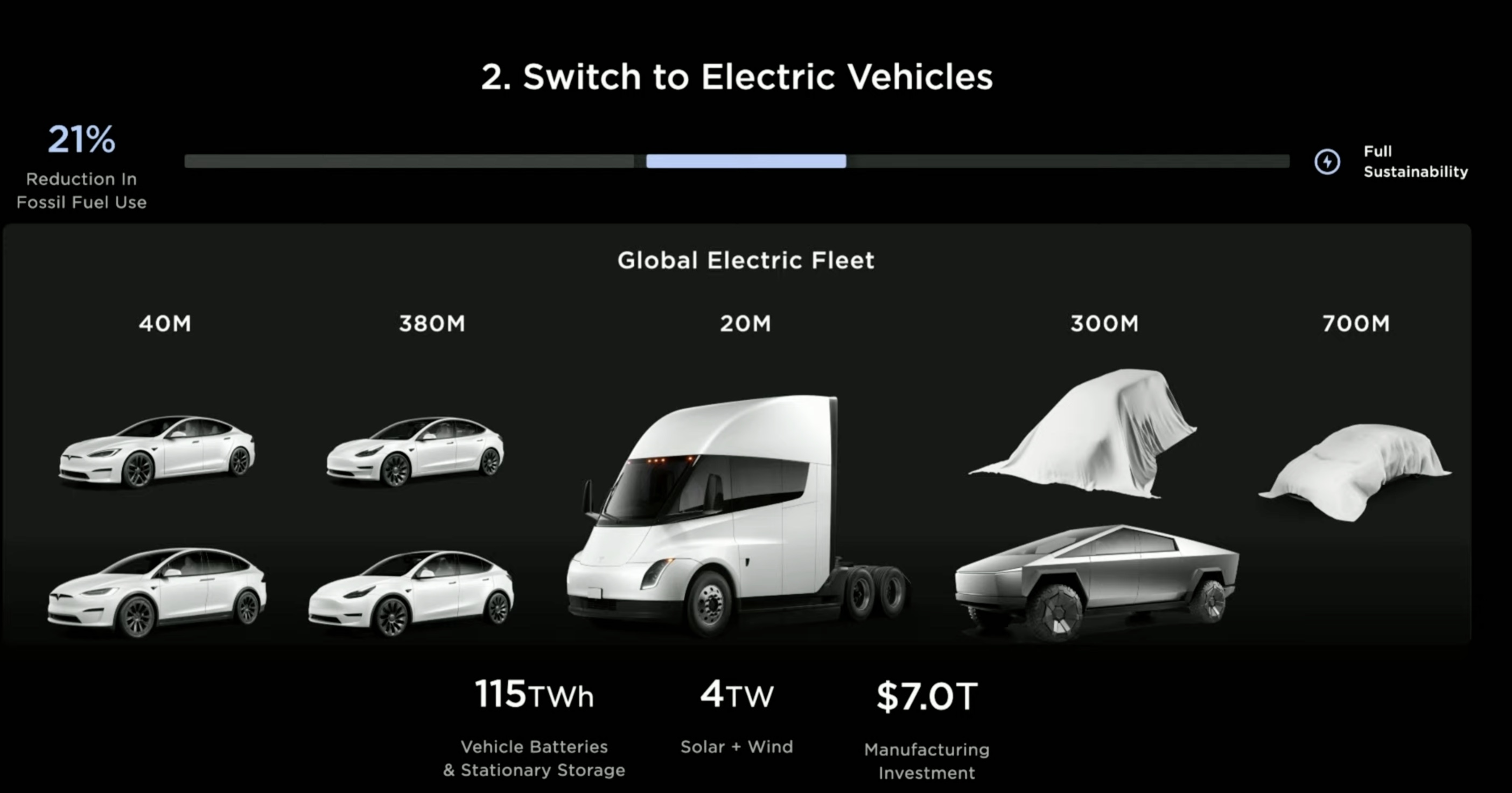
This isn’t a new goal for Tesla. But a string of executives, who came on stage to talk about everything from manufacturing and raw materials to design, charging and batteries, all really tried to prove their case for how they would reach that goal.
The slide above shows the existing portfolio, the Model S, Model X, Model Y and Model 3 — as well as the Tesla Semi and the Cybertruck, and two veiled vehicles.
It’s worth looking at the 20 million vehicles per year number for a bit of a reality check. Tesla produced 1,369,611 and delivered 1,313,851 vehicles in 2022. Toyota, the global sales leader, sold 10.5 million vehicles last year.
That means, and follow the math, Tesla would need to increase its production (and sales mind you) about 15 times from 2022.
So, how will Tesla achieve this? Musk said it’s not a demand problem (a phrase he has used repeatedly in the past). The tough part is building the darned things, he said. Tesla’s answers are: vertical integration, scaling existing factories and building new ones, making the manufacturing process more efficient and adding a few more models. (But, interestingly, not too many; Musk said maybe 10 models total).
Vertical integration and slashing costs
Tesla is famous for its constant push towards vertical integration. It’s the only car company in recent memory that took on making its own seats, for instance.
That message continued at the investor event, with executives discussing different pieces of the vertical-integration goal. Tesla has brought in house already, including building its own chip. But the company has continued to push the bounds of vertical integration, right down to the software it uses for in-house operations. Execs said that recently that got rid of an outsourced software for recruiting to use its own and that it developed its own purpose-built microprocessor for high-power electronics that will reduce costs by half.
For Tesla, vertical integration equals cost reductions. And that’s one of the big aims to achieve that bigger mission.
Lithium plant in Corpus Christi
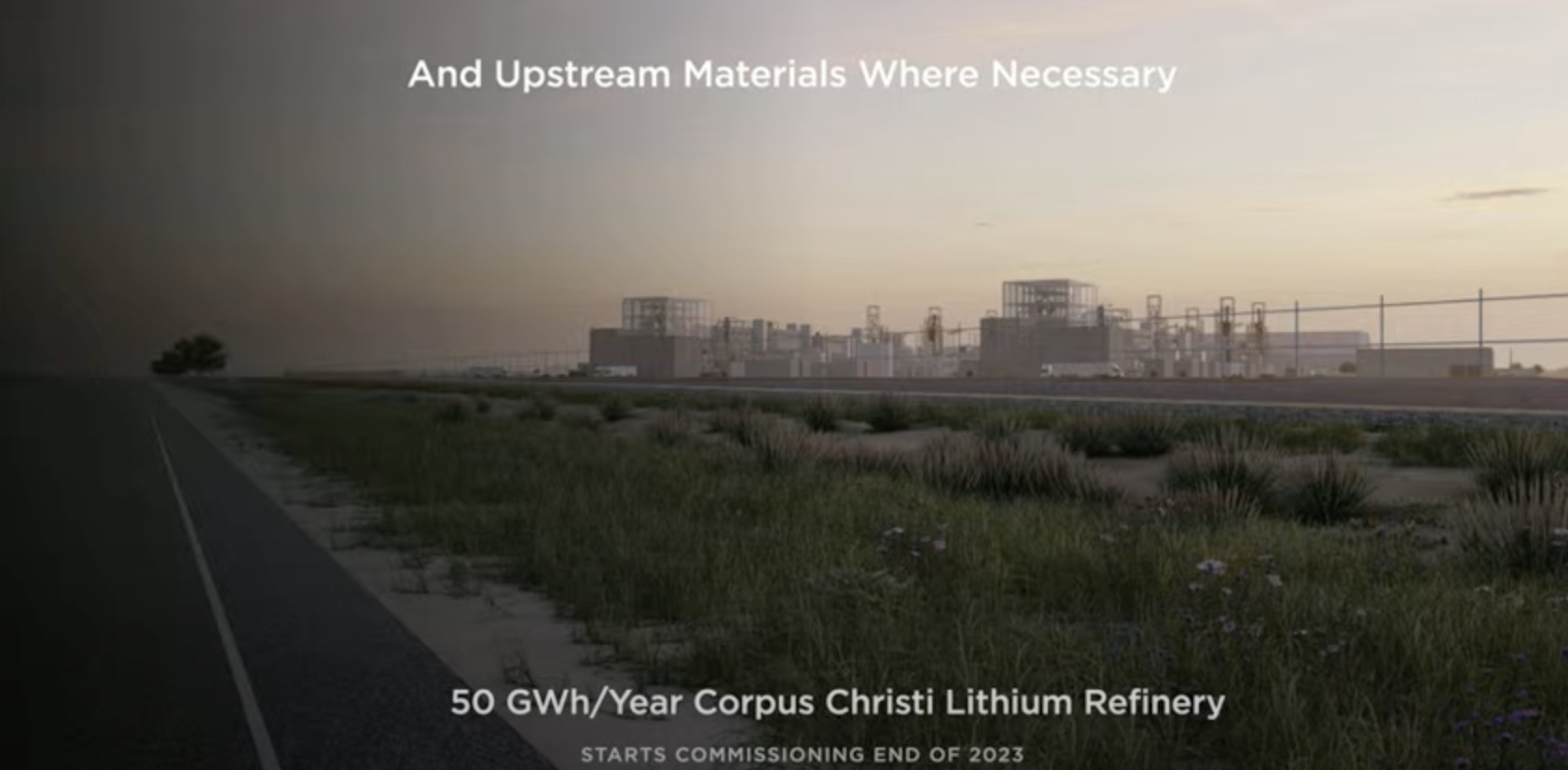
Tesla has even extended its vertical integration efforts to the materials it uses in battery cells.
Tesla officially broke ground at a new lithium refinery in Corpus Christi, Texas, Drew Baglino, senior vice president of powertrain and energy engineering, confirmed during the event.
During the presentation, Tesla showed a rendering of the 50 gigawatt-hour per year lithium refinery. The company’s messaging around speed and scale continued with the refinery project, as Baglino noted they’re working to have it operational by the end of 2023.
“This is a good example of something where we’re basically talking about breaking ground and and starting commissioning within 10 months and with actual production within 12 months,” Baglino said. “That’s the target.”
Musk added later, during a Q&A session, that a cathode processing facility will eventually be built adjacent to the lithium refinery. He also noted that the company would prefer if others took on lithium mining.
“We’re doing it because we have to not because we want to,” Musk said.
Mexico factory
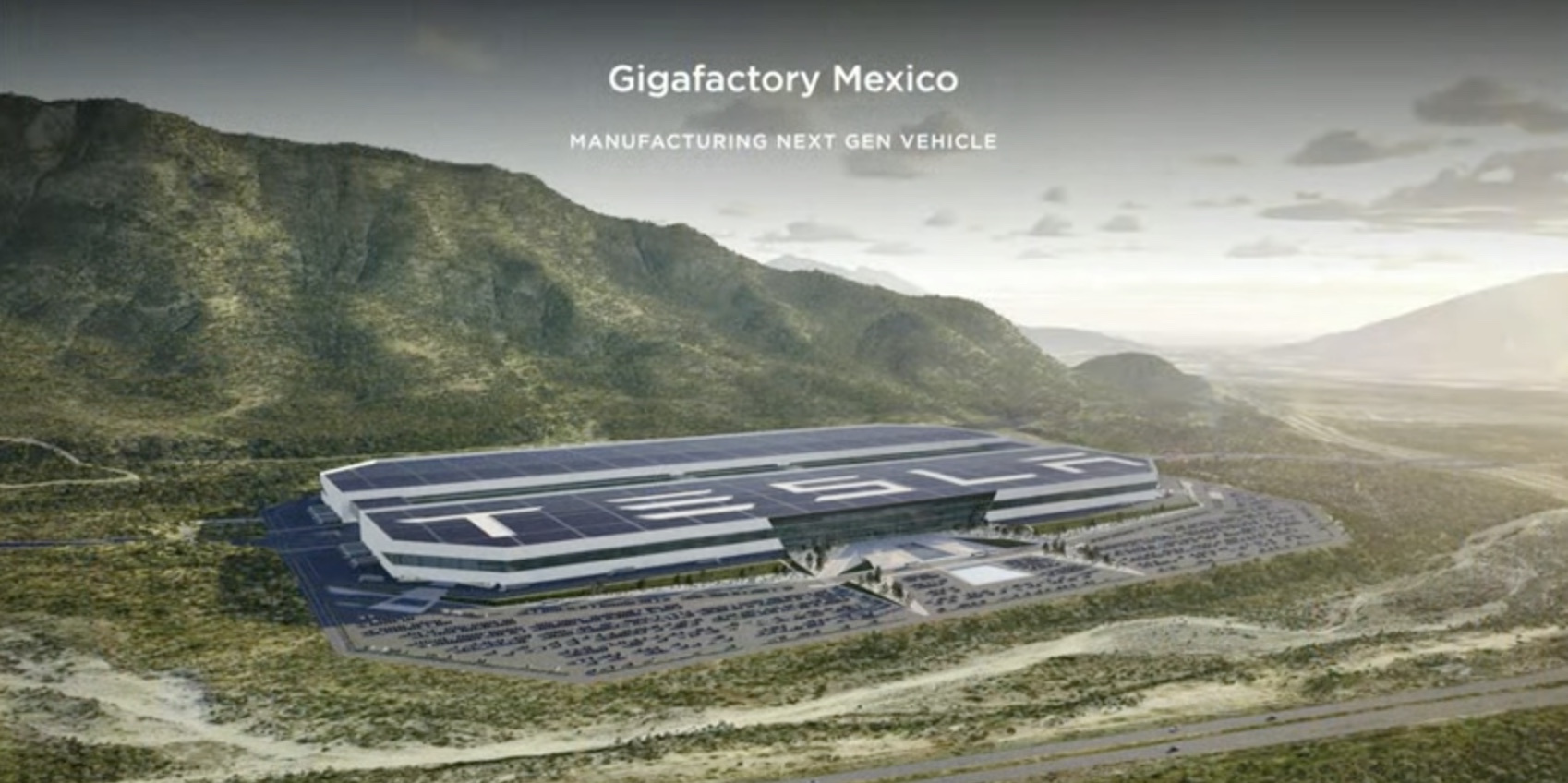
Mexico President Andrés Manuel López Obrador technically broke the news Tuesday, but Musk reiterated the announcement without sharing any new details aside from a rendering.
“We’re excited to announce that the next Tesla gigafactory will be in Mexico near Monterey,” Musk said. “We do want to emphasize we will continue to expand production at all of our existing factories, including California, Nevada, here in Texas, Shanghai, so we intend to increase production at all factories. So the Giga Mexico would be supplemental to the output of all the other factories.”
Musk went on to tease a grand opening event at the factory.
Next-gen vehicles
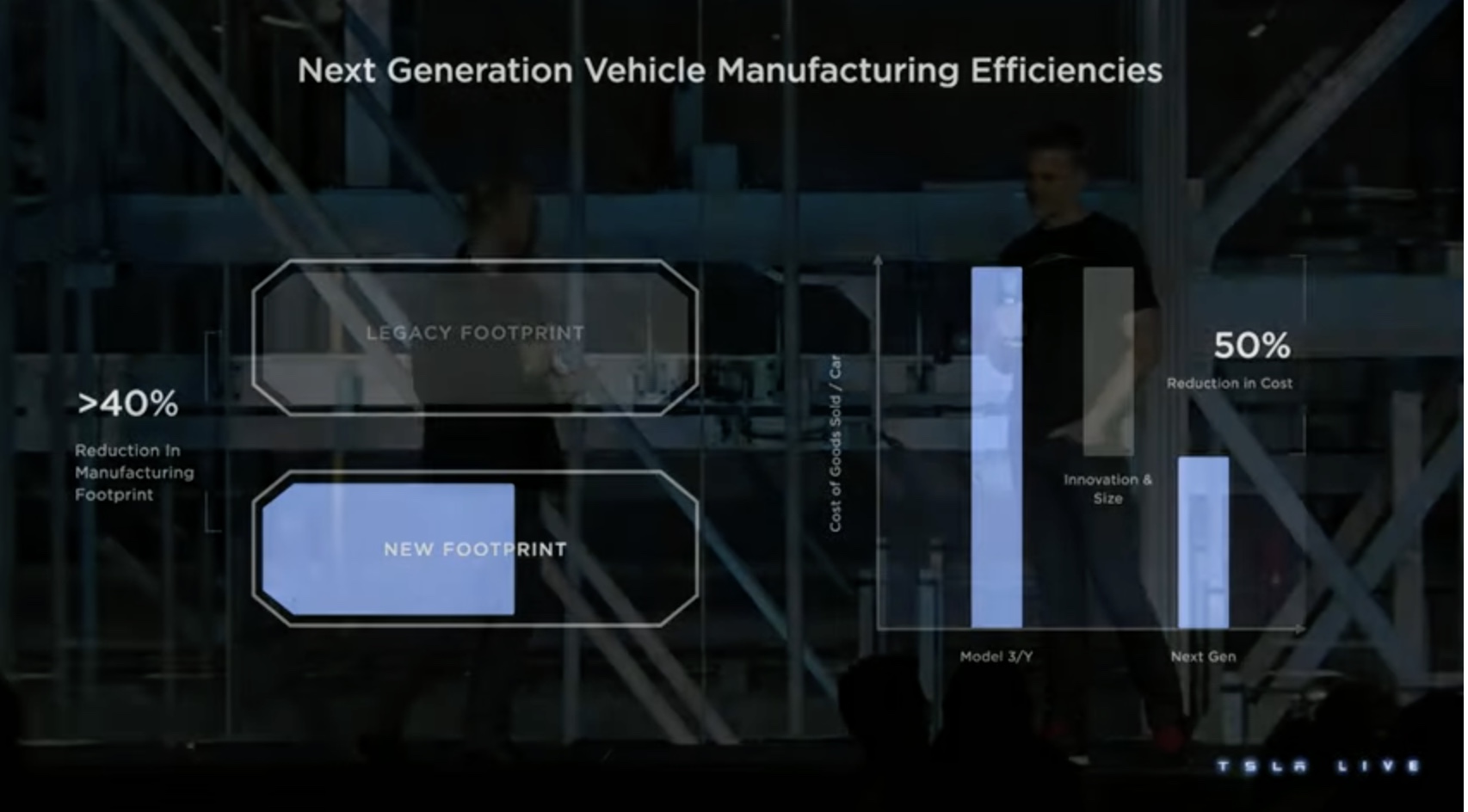
As we mentioned above, Tesla displayed two veiled vehicles during the presentation, hinting at how it will build its next-generation of vehicles on a completely different platform design. A big part of that design is building in a way that relies on automation to scale faster and cheaper.
“It’s going to look something like this where we build all the sides of the cars independently, we only paint what we need to, and then we assemble the parts of the car once, and only once. We put them where they need to go,” Baglino said.
Baglino noted that this would mean more people and robots having the space to work on separate pieces of the car, rather than lugging heavy objects to a central buildout. What that looks like on the factory floor is sub-assemblies, wherein the front, rear and floor with seats are assembled separately, and then put together at final assembly.
“To increase the scale of adoption of electric vehicles to the orders of magnitude that we just showed you, we have to make constraints part of the solution,” he said. “It leads us to greater than 40% reduction in footprint, which means we can build factories faster, with less capex and more output per unit dollar.”
While that theoretically sounds neat, factories are dangerous places and when more people work in closer quarters, injuries can happen.
Neither Baglino, Musk nor head of design Franz von Holzhausen gave additional details on next-generation vehicles. The only hint: This next-gen design may also be used on the Cybertruck, according to Baglino.
Rare earths

As part of Tesla’s next-gen design, the company is developing a new drive unit that it says will be more scalable, in large part because it will eventually eliminate the use of rare earth materials.
“We have designed our next drive unit to use a permanent magnet motor to not use any rare earth materials at all,” said Colin Campbell, VP of powertrain engineering, noting that the new drive unit cost has been reduced to $1,000. Those savings could, in theory, be passed onto the consumer to make for a more accessible, affordable EV.
Tesla said its next powertrain will also use 75% less silicone carbide without compromising performance or efficiency of the vehicle. The new powertrain is also compatible with any battery chemistry, which will give Tesla more flexibility in battery sourcing, said Campbell. Finally, Tesla’s new powertrain factory is apparently 50% smaller than the current one in Austin, which Campbell said means faster scaling of EV production.
Heat pumps
The third part of Tesla’s Master Plan Part 3 is to switch home, business and industrial heating to heat pumps. Most of that portion of the presentation was just a Climate Tech 101 on the ill effects of traditional heating systems and how heat pumps could help. Musk said at some point Tesla might consider building heat pumps for the home to help solve this problem.
Tesla already produces heat pumps for its cars, so expanding into homes wouldn’t be far out of left field. But if you have a gas or oil heater, the good news is you don’t have to wait for Tesla to replace it. Plenty of other companies already do this, including Sealed and BlocPower.
Charging and energy storage
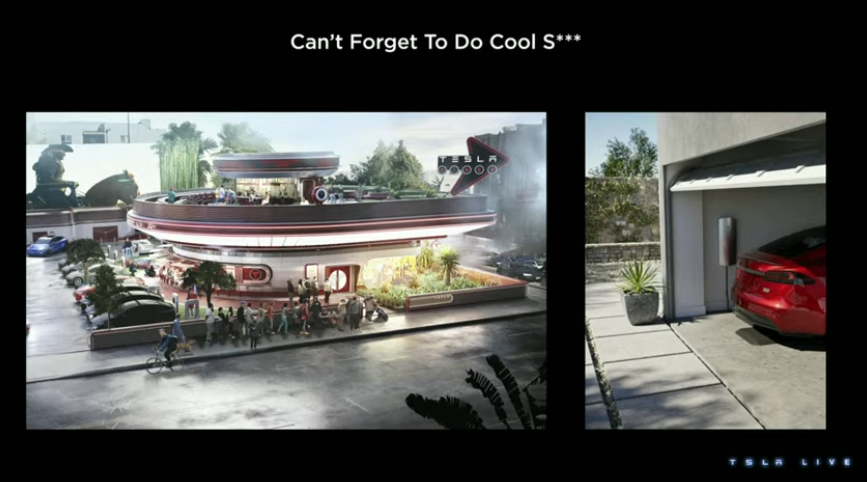
Tesla broke up its info-dump with some announcements, and several hints, on the future of its EV charging and energy storage businesses. Most concretely, the automaker formally introduced Magic Dock, an upgrade to Tesla’s charging stations which opens them up to vehicles that aren’t Teslas. Rolling out the tech will enable Tesla to tap into billions in federal subsidies.
Tesla also said it will add a $30 “unlimited overnight home charging” plan to Tesla Electric in July. An invite-only electric plan, Tesla Electric is exclusively available to Powerwall havers in parts of Texas where retail choice exists. Tesla added that it aims to expand its electric plan into other areas — “market by market, in the same way that we’ve approached Tesla insurance.” The company offered no specific dates.
Later, the automaker said it would debut new energy storage products in 2023. One chart shown to investors appeared to depict new megapack and powerwall designs, also hidden beneath illustrated veils. Take this with a grain or more of salt; Tesla has a track record of missing its own deadlines.
Robot
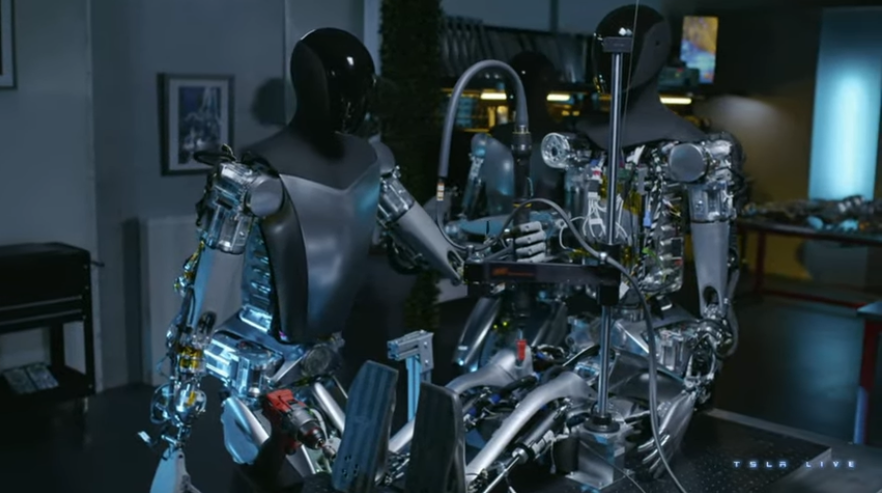
Tesla teased a little more information about its humanoid robot, the Optimus, with a video showing two robots slowly building another bot — a big step up from the prototype Tesla showed last October at AI Day.
As usual, Musk stated that Optimus will be worth significantly more than the car side of things. Optimus is trained using the same AI that trains Tesla’s Autopilot and FSD, and Musk detailed how even much of the hardware for Optimus is taken from Tesla’s cars.
“The actuators in Optimus are all custom designed Tesla actuators,” said Musk. “We designed the electric motor or the gearbox, the power electronics, obviously the battery pack and everything else that goes into Optimus. The same team that designed the groundbreaking electric motors that are in the Model S Plaid designed the actuators in the robot.”
What this means, said Musk, is that Tesla has the tools to bring an actual humanoid robot product to market at scale. Now it’s just a question of timing. And also, apparently, of what the ratio of humans to humanoid robots will be. Musk reckons it’ll be greater than one-to-one because the robots can be used at homes, in industrial use cases and more.
How the robot fits into Tesla’s Master Plan Part 3, which is focused on a sustainable energy future for Earth, isn’t exactly clear.
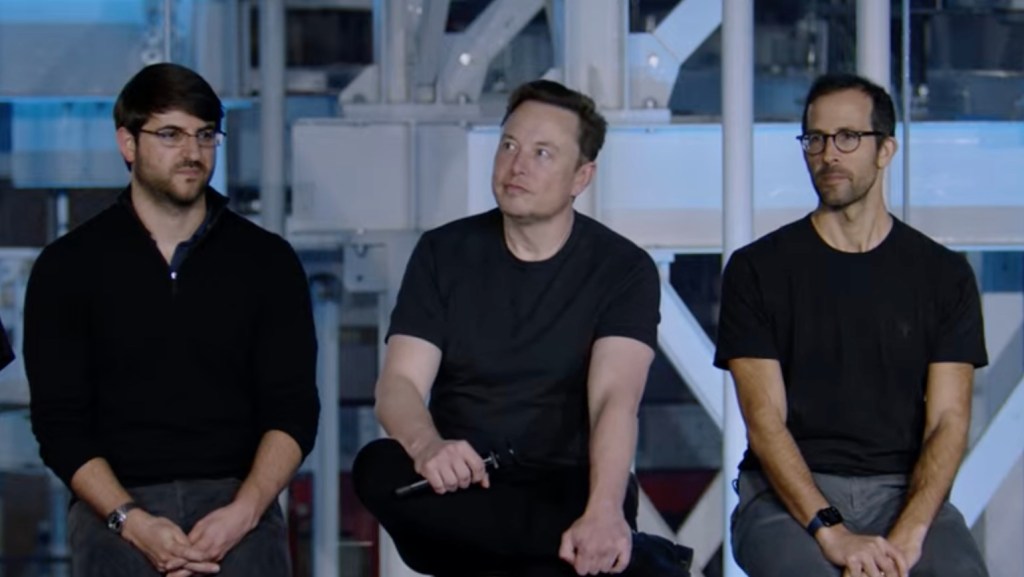






























Comment